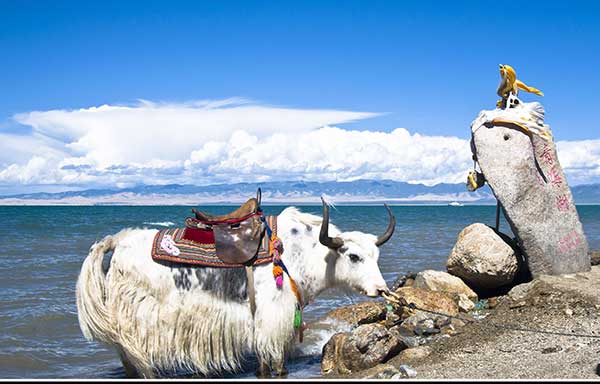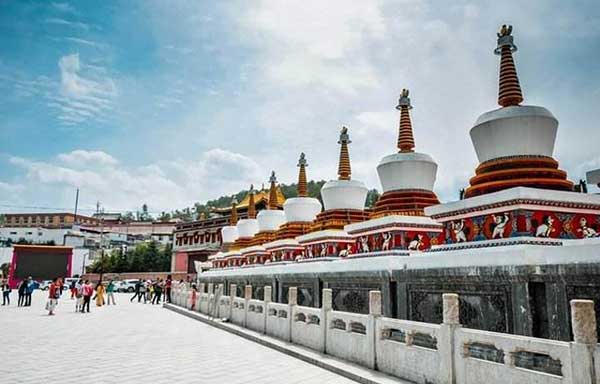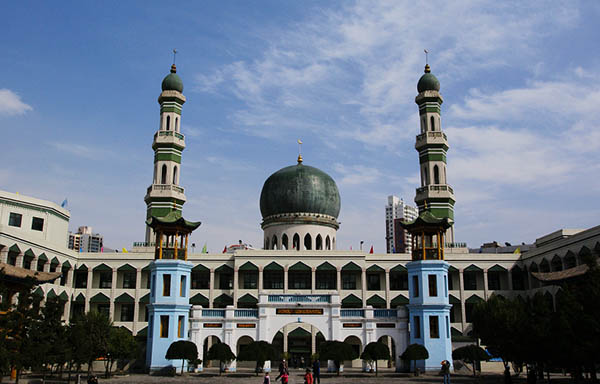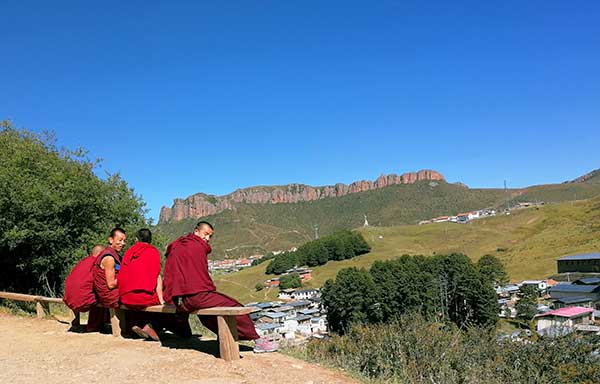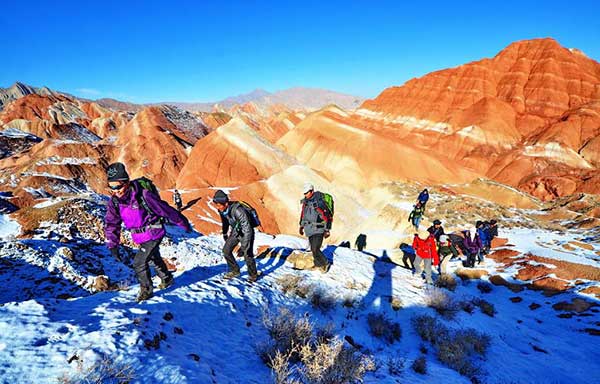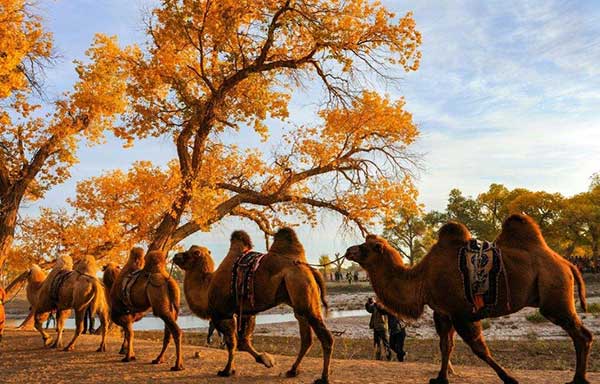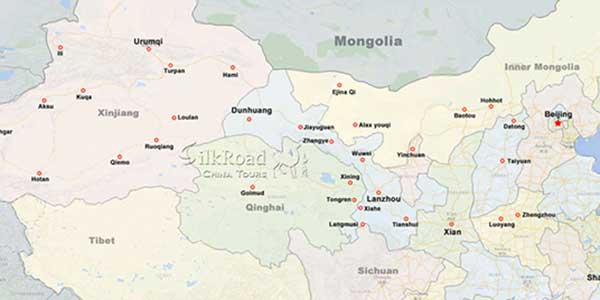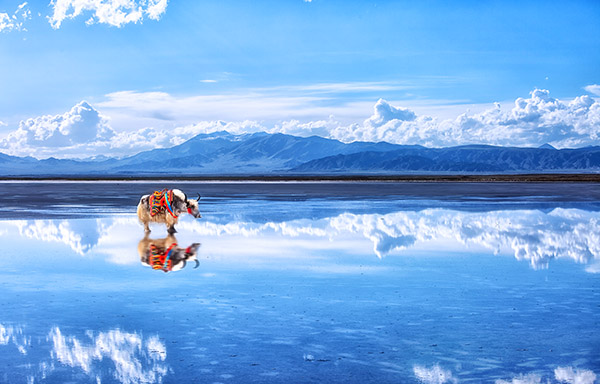 Chaka is the Tibetan name of the lake, which means salt lake. Local Mongolians call it Dabuson Nor which has same meaning with Chaka – Salt Lake. Its located in Ulan county of Qinghai Province , 298km from Xining. This natural crystallized saline lake is regarded as the eastern gateway to Qaidam Basin, which reserves the largest salt mine in the world. Lying at an altitude of 3,059 meters (10,036 feet), the lake is oval shape and covers an area of 105 square kilometers (40 square miles), ten times larger than the West Lake of Hangzhou. However, it is the smallest among the several salt lakes in Qaidam area, but different from others for its coexistence of both solid and liquid salt.
Chaka is the Tibetan name of the lake, which means salt lake. Local Mongolians call it Dabuson Nor which has same meaning with Chaka – Salt Lake. Its located in Ulan county of Qinghai Province , 298km from Xining. This natural crystallized saline lake is regarded as the eastern gateway to Qaidam Basin, which reserves the largest salt mine in the world. Lying at an altitude of 3,059 meters (10,036 feet), the lake is oval shape and covers an area of 105 square kilometers (40 square miles), ten times larger than the West Lake of Hangzhou. However, it is the smallest among the several salt lakes in Qaidam area, but different from others for its coexistence of both solid and liquid salt.
The lake is very shallow —at places, it is only ankle-deep— that allows visitors to walk over the lake. At times, when the sky is looking brilliant, the crystal blue water of the lake reflects the azure sky as if a giant mirror is resting on the ground. This has earned Chaka Salt Lake the nickname of ‘Mirror of the Sky’.
The region where the lake is located was once a shallow sea. Tectonic movement then raised this block of ground more than 3,000 meters up to form the huge Qinghai-Tibet plateau. Small pockets of residual seawater in this plateau turned into saline lakes, one of which is Chaka Salt Lake. More salt from the mountains flowed in along with rainwater and seasonal rivers, and over time the salinity of the lakes increased. There is now over 5 meters of salt in Chaka Salt Lake.
The salt lakes of the Qaidam Basin has been mined for more than 3,000 years. During the times of the Western Han Dynasty (206 BC—AD 25), the local people of Qiang ethnic minority depended on the lakes for salt. Salt also came from other places such as Xian Lake, which is now called Qinghai Lake, and Salt Lake in Jincheng County.
Large scale exploitation of salt began in the second half of the 18th century. Due to the large reserves, mining is not at all difficult as natural salts can be obtained by just uncovering the top layer of the lake. Large scale mining is done mechanically nowadays allowing Chaka’s salt factory to annually produce hundreds of tons of high-quality crude salt that gets sold around China, and are even exported to Japan, Nepal, and the Middle East.
The beautiful sunrise and sunset sceneries are highly recommended. The best time to visit would be from July to August. It is believed that with the summer breeze, inhaling the humid air with its salt content is especially good for the lung.
There is a long railway track extending to the center of the lake. Visitors can walk along the track to view the splendid scenery on the water. The magnificent mining scene of the large modern salt dredgers is the most impressive.
Attractions in the area
Related Tours
General Information
Alias: No
Loc: 298 km from Xining
Entrance: 70 RMB
Open Time: 07:00 ~ 21:00
Relevant blogs
-
How did the name of Tianshui in Gansu come about?
The name Tianshui is very pleasant to the ear, and it reminds one of that exquisitely beautiful verse, "After getting drunk, one doesn't know if the sky is in
-
The 8th Silk Road Hotel Festival was successfully held i
On December 27th, the "8th Silk Road Hotel Festival" grandly opened at the Yujing International Hotel in Zhangye. This hotel festival gathered industry experts,
-
The Karez Irrigation System in Turpan has been selected
On September 3rd, at the 75th Executive Council Meeting of the International Commission on Irrigation and Drainage held in Sydney, Australia, the 2024 (11th bat
-
What is the connection between "dragons" and "snakes
In traditional Chinese culture, the snake has a dual identity of auspiciousness and danger. Ancient people believed that the snake not only possesses divine cha
-
Endangered Przewalski's Horses Spotted at Dunhuang Yume
<p>In early February, a group of special "visitors"—the Przewalski's horses—appeared at the Dunhuang Yumen Pass scenic area in Gansu Province, a U
-
The Fourth Dunhuang Cultural Tourism Supplier Conference
On the morning of February 18th, the Fourth Dunhuang Cultural Tourism Supplier Conference in Northwest China commenced at the Dunhuang International Convention






